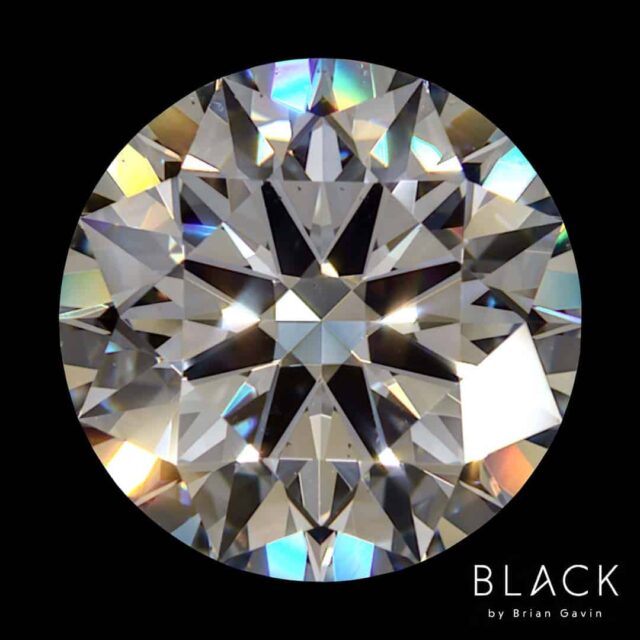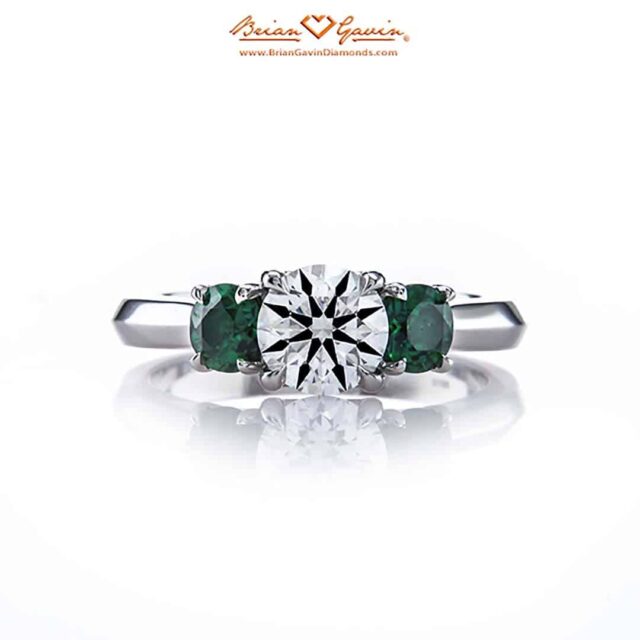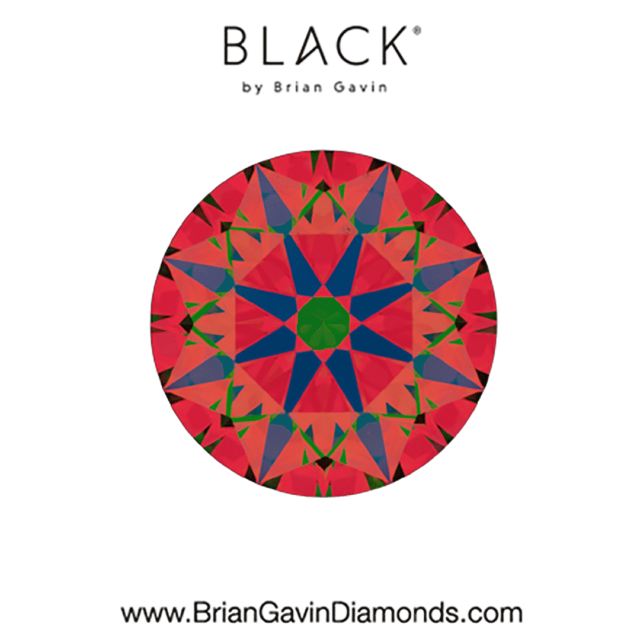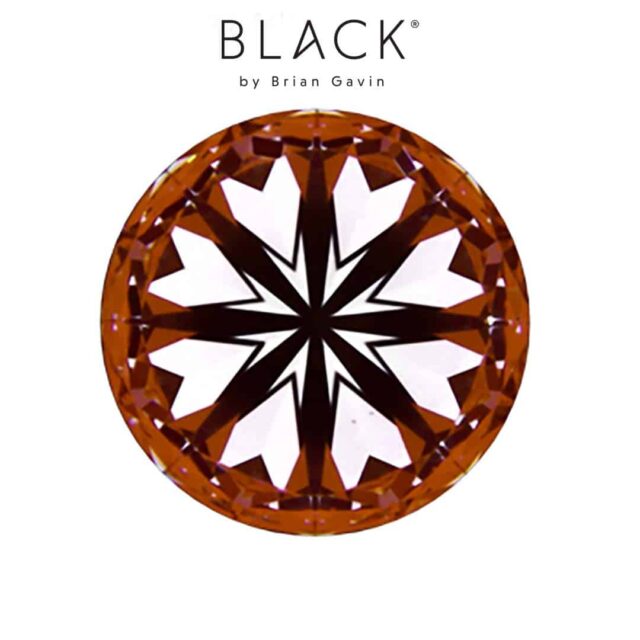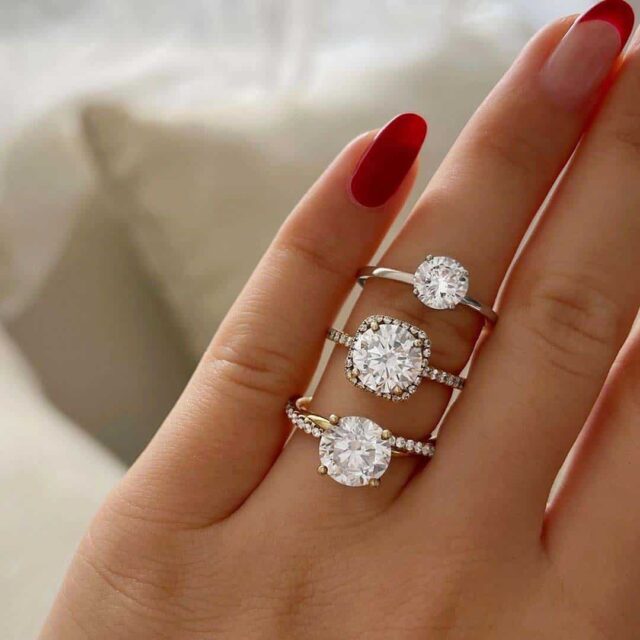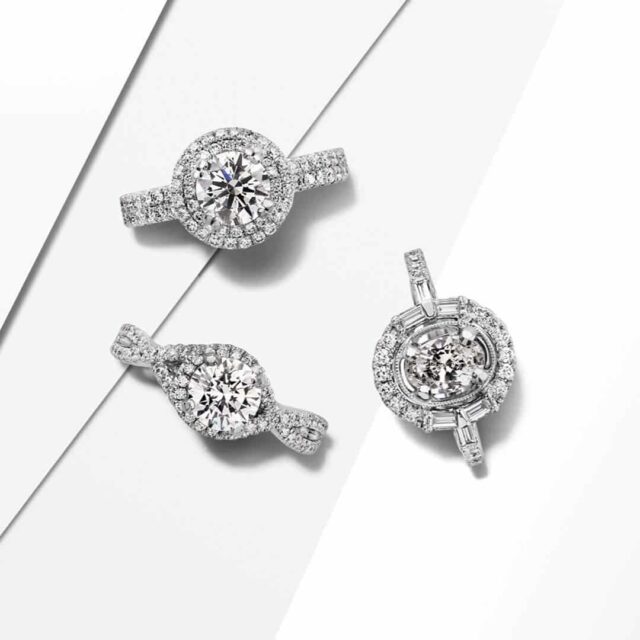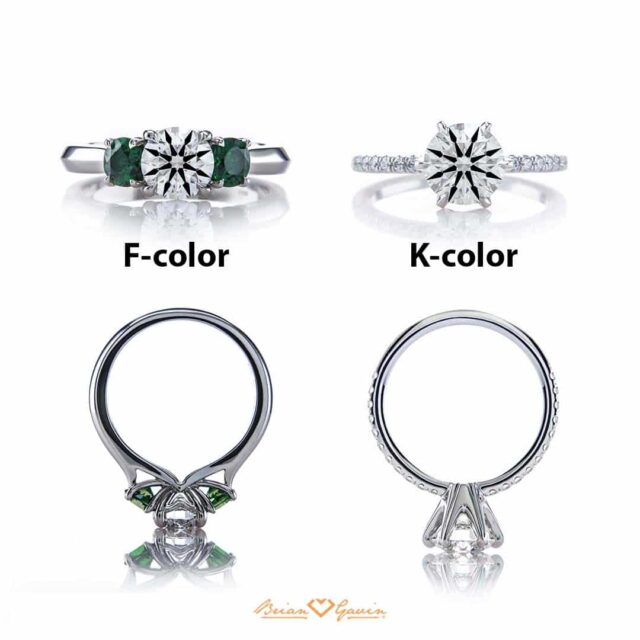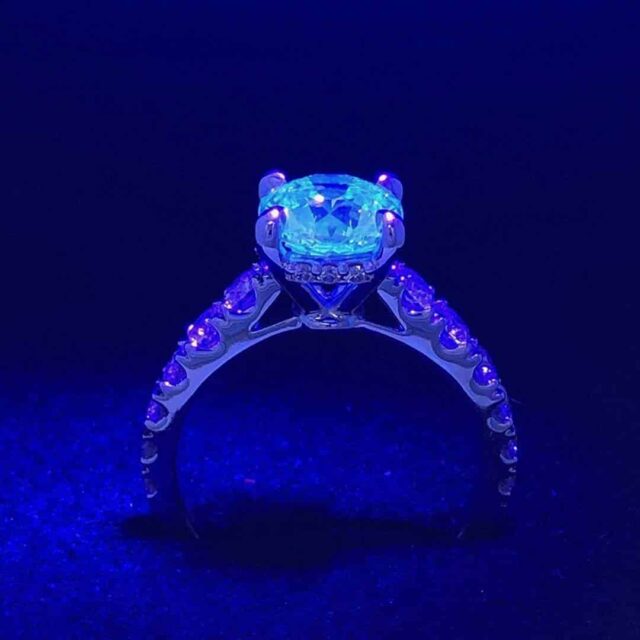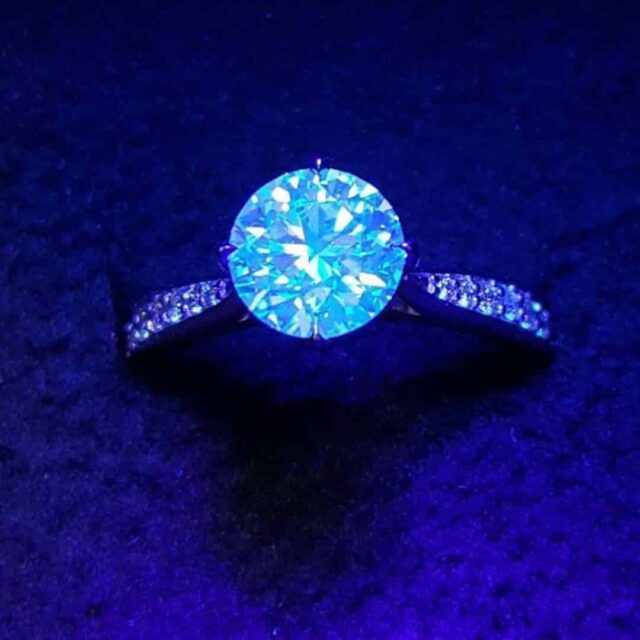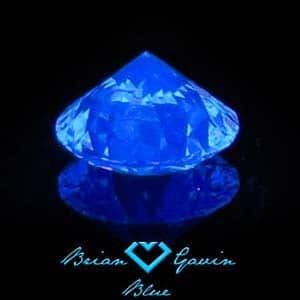This Diamond Buying Tutorial will explain maximizing sparkle factor and light performance in modern round brilliant cut diamonds using specific proportions.
Let's begin by throwing caution to the wind and agreeing that diamond cutting is more of a science than an art. Consequently, that position will likely upset most diamond cutters.
However, the reality is that diamonds are three-dimensional models. In that case, it's a simple matter of geometry, and the proportions will directly impact light performance.
Simultaneously, the consistency of facet size, shape, and alignment will dictate the sparkle's size and intensity. In other words, the volume of light return will be in direct proportion to the pavilion angle.
Diamond and Jewelry Coupons & Sales:
* See individual sites for terms and conditions.
Balancing Brilliance & Fire:
The crown angle will determine the balance of brilliance (white sparkle) and dispersion (colored sparkle/fire). Simultaneously, the degree of optical precision will determine the size and intensity of the flash.
If you want to save a lot of time and get it right the first time, you should buy a Brian Gavin Signature diamond. After all, he cut the diamond for my wedding ring and my son's engagement ring.
That says a lot since I have 35+ years of experience as a diamond buyer. That means that I know what to look for and the best places to find it. Consequently, my family buys their diamonds from Brian Gavin because they exhibit the most spectacular sparkle we've ever seen!
Standard Ideal Cut & Beyond:
First, I want to encourage you not to make the same mistake that most people do. That is assuming that focusing on AGS Ideal and GIA Excellent cut diamonds is good enough. This diamond buying tutorial will show that the overall cut grade is only the beginning.
Here is the lab report for this 1.13 carat, I-color, VS-2 clarity, James Allen True Hearts diamond. Consequently, the proportions are within the range we recommend, and the overall cut grade is GIA Excellent.
In that case, the 40.8 degree pavilion angle should produce a high volume of light return. At the same time, the 34.5 degree crown angle makes a virtual balance of brilliance and dispersion.
Identifying Light Leakage:
The Ideal Scope image above reveals a moderate amount of light leakage. That is what the light pink and semi-transparent sections that the light-green arrows are pointing to indicates.
Under those circumstances, you can see why it's essential to look beyond basic lab report details. Of course, that is just one example from the James Allen True Hearts collection. I chose that particular diamond to demonstrate the importance of looking beyond cut grade basics.
In comparison, there are other diamonds in that collection that exhibit better light return. Needless to say, that you should pay particular attention to the images to make the best choice.
Best Proportions a’ la Engineer:
You're in luck if this is the first diamond buying tutorial you've read because you'll get started on the right foot. We're going to teach you to adhere to an incredibly tight range of proportions.
After all, we've already proven above that ideal cut diamonds can still leak a lot of light. In that case, it makes sense to hedge your bets by focusing on the middle of the spectrum. That sweet spot in the middle of the range should be the target of your focus.
In other words, the proportions guidelines for the ideal cut rating encompass a range or spectrum of possibility. Under those circumstances, there is the middle target zone and the lower and outer edges where more leakage occurs.
Look at the ASET for this 1.806 carat, F-color, VS-1 clarity, Black by Brian Gavin Diamond. Notice how evenly light reflects throughout the diamond and the consistency of hue and saturation. Here is a diamond that will outperform all others because it exhibits the highest degree of optical precision.
Don't fall into the trap of thinking that a diamond will perform well because of the overall cut grade. After all, you could drive a truck through the gap between the low and high-end of the scale! Making you aware of that fact is the purpose of this diamond buying tutorial.
(Maximum)2 Brilliance + Dispersion:
Given that a diamond is a three-dimensional model, it stands to reason that specific proportions perform better than others. The middle of the spectrum is the target for the ideal cut rating. In contrast, the outer edges of that range will not perform as well.
In other words, we recommend the range of proportions below for a reason. It tends to produce a high volume of light return and a virtual balance of brilliance and dispersion.
If you deviate from the pavilion angle, then you'll see less light return. And if you vary from the crown angle, you won't see a balance of brilliance and dispersion.
Although that may be true, they like to say that there is an ideal cut diamond for every preference. In other words, you might prefer a diamond that exhibits more brilliance or dispersion.
In that case, you might prefer a crown angle that is shallower or steeper than what we recommend in this diamond buying tutorial. However, we strongly recommend that you do not deviate from the pavilion angle, or the light return will suffer.
Best Proportions for Performance:
This diamond buying tutorial focuses on maximizing light return and performance. For that reason, we recommend the range of proportions below. Any variance from this narrow range is likely to increase light leakage and produce less intense sparkle.
* Crown Angle:
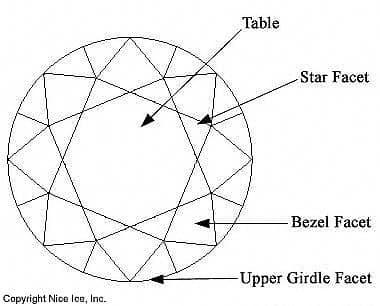
Diagram of Crown Facets.
The range of crown angles for round brilliant cut diamonds shown above is relatively narrow. That is because it produces a virtual balance of brilliance and dispersion when offset by a 40.6 - 40.9 degree pavilion angle.
The purpose of this diamond buying tutorial is to help you find the best performing diamonds and eliminate the guesswork. In that case, we recommend specific crown/pavilion angle offsets that perform well.
Although that may be true, you might prefer a different balance of white and colored sparkle/fire. In that case, you should look at enough ideal cut diamonds to determine your preference.
** Lower Girdle Facet length:
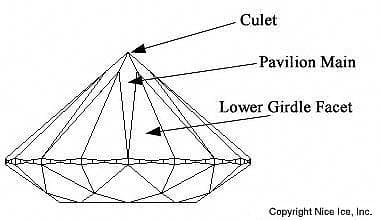
Diagram of Pavilion Facets.
In the first place, there is a reason why we recommend a Lower Girdle Facet (LGF) length between 75 – 78% in this diamond buying tutorial. Specifically, that is because it's more likely to produce broad-spectrum sparkle.
Consequently, those flashes of light will look bolder, brighter, and more vivid than the pin-fire type sparkle that 80-82% lower girdle facets produce.
Lower girdle facets shorter than 75% are also likely to make the arrow shafts look short and stubby. Needless to say that this will also affect the appearance of the arrows and the degree of contrast brilliance.
*** Star Facet Length:
Star facets are the small triangular-shaped facets that are on the top crown section of the diamond. They are the triangles between the kite-shaped bezel facets, right along the table's outside edge facet.
Consequently, the star facets' length will affect the rounding of the shoulders on the hearts in H&A Diamonds. In that case, the star facet length is an integral part of the formula for Brian Gavin Signature Hearts and Arrows diamonds.
However, you'll also notice that the measurements don't always line-up tightly with our preferred range. That's because the stars are "minor facets" that the cutters tweak to maximize performance. For that reason, we tend to focus more on the consistency of the hearts pattern than the star facet length.
Under those circumstances, it's perfectly acceptable for the star facet length to be between 40 - 58%. Of course, we are assuming that the ASET Scope confirms the superior light performance.
This Diamond Buying Tutorial Kills 99% of Rounds:
You're going to LOVE this diamond buying tutorial if you're looking for the best light performance. And you're going to HATE IT if you're a diamond cutter who relies on the broad range of ideal proportions to sell drek.
After all, the range of proportions that we recommend eliminates 99% of the round diamonds produced in the average year. In other words, this diamond buying tutorial focuses on the Top 1% of the annual production for round diamonds.
While the super ideal cut diamonds from the vendors below are more like the Top 0.001%:
Although that may be true, you'll see that these diamonds exhibit varying degrees of light performance. That's because they are turned on the wheel by hand. In that case, we rely on the insight provided by Advanced ASET and the H&A images to cherry-pick the best of the best. Click on the banner below and use our Diamond Concierge Service to sift the wheat from the chaff.
Polish & Symmetry:
You want the best polish and symmetry grade possible because that reflects the degree of polish and facet alignment. Although that may be true, the symmetry grade on the diamond grading report is not the same as optical precision.
You'll recall that optical precision is the consistency of facet shape, size, and alignment. In comparison, meet-point-symmetry is what the lab report describes. That mostly describes how well the points of the facets meet-up at the junction points.
The degree of optical precision is why the James Allen True Hearts diamond above is leaking light. Be that as it may, the Symmetry grade on the diamond grading report is Excellent.
In that case, the polish and symmetry grades on the lab report are only the beginning. Of course, we're only going to touch on that subject in this diamond buying tutorial. Here is a more in-depth article on cut quality and precision.
Diamond Color:
What diamond color is best for you is strictly a matter of preference. In other words, one diamond color is not necessarily better than another. That's because one person might prefer diamonds that are cooler in tone, such as D-E-F color.
In contrast, another person might like diamonds that are warmer in hue and saturation, such as K-L-M color. At the same time, the perception of diamond color is subject to the environment and lighting conditions.
For example, the color of the prongs that hold the diamond in place can affect the appearance by one color grade. Under those circumstances, we suggest that you consider the following only to be a suggestion:
D-E-F colorless:
Colorless diamonds tend to be bright white and exhibit cooler tones. They're going to deliver that surefire white similar to the brightness of photo-grade paper. It's a great choice if you've got the big bucks and don't want to second-guess yourself.
G-H-I-J near-colorless:
G-color is an excellent choice because most people can't distinguish the difference between F-color. In that case, there is no need to pay a premium for color beyond the mental bump that F-color provides.
Although that may be true, the difference between F-G colors is visible under controlled lighting from a side-profile. Under those circumstances, we still think of G-color as colorless.
While it is apparent to us that H-I color is near-colorless because there is a little more warmth. That statement is in relationship to the comparison of H-I color to G-color. If we're sticking with the copy paper analogy, then the H-I color is similar to bright white copy paper.
Whereas J-color diamonds exhibit tones like the generic copy paper that we use for everyday purposes. As such, it tends to appeal to people who are looking to stretch their budget.
In other words, you should consider J-color diamonds if you're willing to exchange a little color for the carat weight. After all, it's still going to face-up white, and it's just going to be a little warmer than the H-I color.
K-L-M light yellow:
I'm not too fond of the term light yellow as it applies to white diamonds. That's because we tend to think of color as it relates to a box of Crayola Crayons. Although that may be true, diamond crystals are transparent, and crayons are solid. In that case, there are distinct differences in the saturation of color.
With that in mind, take a look at the F-K color Brian Gavin Signature diamonds on the left. In this case, the 3-stone ring on the left is my son's engagement ring, and the pavé solitaire on the right belongs to one of my clients.
Consequently, both rings are platinum, and that tends to make the diamonds look whiter. That's because the metal color that touches the edge of the diamond reflects throughout the stone.
Under those circumstances, you might consider buying a light yellow K-L-M color diamond because it's not going to look solid yellow like a Crayola Crayon. Instead, it's more likely to exhibit a little bit of warmth and sparkle like the sun. If that sounds inviting, you should check out diamonds from the Brian Gavin Cape Collection.
Blue Fluorescence:
No diamond buying tutorial would be complete unless it covers the phenomena of blue fluorescence. Although that may be true, the reality is that blue fluorescence is little more than an identifying characteristic.
From that perspective, our recommendation whether to buy a blue fluorescent diamond depends on whether you like the color blue. After all, a blue fluorescent diamond is going to glow neon-blue when exposed to black light.
In contrast, a diamond with negligible fluorescence will not react to black light. Both diamonds will look perfectly normal (white) under real-world lighting conditions that don't involve black light. On that note, notice how the accent diamonds on the left reflect the black light bulb's color.
Negligible, None, and Faint Blue:
Low levels of fluorescence in the range of negligible to faint blue are not likely to affect the perception of color. In that case, faint blue fluorescence is nothing more than an identifying characteristic.
Note that the AGS and GIA laboratories evaluate diamonds for fluorescence in slightly different ways. The AGS Laboratory grades diamonds in the face-up position as you will see them in a ring. In contrast, the GIA evaluates them from a side profile tilted back at a slight angle.
In case you're wondering, we think that the AGS Laboratory approach makes more sense. After all, you're going to be looking at your diamond in the face-up position most of the time.
Although that may be true, the difference in methodology can create slight differences in the fluorescence ratings between the two laboratories. For example, the AGS might give a diamond a negligible fluorescence rating, which is not enough to measure.
In comparison, the GIA might deem the diamond to exhibit faint blue fluorescence from a side-profile. Be that as it may, the difference between negligible and faint blue fluorescence is relatively mute.
Medium Blue Fluorescence:
Generally speaking, medium blue fluorescence gives off a light lavender-blue hue under black light. When the fluorescent molecules are activated, they tend to enhance the natural color of most diamonds.
In other words, they can make them look whiter and brighter. The blue fluorescence serves to filter out some of the yellow undertones present in diamonds of all color grades.
If it's any reflection of where we stand on the subject, most of the diamonds we choose for ourselves exhibit medium to strong blue fluorescence. The photograph of the Brian Gavin Blue fluorescent diamond on the left shows medium intensity.
Some people worry that medium blue fluorescence might make their diamond look cloudy. The GIA determined that there is a negative impact in less than 2% of gem-quality diamonds. In those cases, the level of fluorescence was very strong to distinct blue and over-blue.
Strong Blue Fluorescence:
In most cases, strong blue fluorescence is only going to improve the appearance of a diamond. That is especially true if the diamond is in the near-colorless to faint yellow or warmer color range.
As with medium blue fluorescence, it is unlikely that there will be any negative impact. Note that we only recommend diamonds that exhibit blue fluorescence. In other words, we do not recommend diamonds with fluorescence in different colors.
For example, green, red, orange, white, or yellow. That's because it can affect your perception of color. Of course, you might decide to buy such a diamond anyway for the novelty value.
Diamond Clarity:
In the first place, people tend to worry a lot about diamond clarity. On the one hand, I suspect that it's because they think that higher clarity diamonds perform better.
Consequently, that might be true to some extent on some microscopic level. However, you're not going to see a difference once you go over VS-2 clarity unless you're using magnification.
In other words, a VS2 clarity diamond is going to look the same as a Flawless diamond to the naked eye. That's because VS-2 clarity diamonds tend to face-up eye-clean. In that case, there isn't a need to pay more for higher clarity.
Be that as it may, it's still worth including VS-1 and higher in your search. Because sometimes, the cutters discount higher clarity diamonds to make them competitive with those of lower clarity. True story, don't overthink it.
SI2 Clarity & Lower:
I've never seen an SI-2 or lower clarity diamond that I'd call eye-clean. That's because I've always been able to see the inclusions readily and immediately without magnification.
You'll read down below that we say the same thing about SI-1 clarity diamonds. Although that may be true, you'll see online references about SI-clarity diamonds being eye-clean. And they are to some extent, but there is also a little bit of wordplay involved.
The Industry Definition of Eye-Clean:
According to the GIA Gemology course material, here's the procedure for determining whether or not a diamond is eye-clean. You're going to glance at the diamond from a distance of 9-12 inches. And if the inclusions are not "readily and immediately visible," then the diamond is eye-clean.
Now riddle me this, Batman. When you're buying or receiving a diamond, do you merely glance at it? The answer is obviously no. And that's where things go off the rails because people take the statement literally when diamond dealers say that a diamond is eye-clean.
Of course, the dealer is saying that the diamond is eye-clean when viewed from 9-12 inches in the face-up position. Under the conditions, you merely glance at it; but the inclusions might be visible if you scrutinize the diamond from a closer distance.
Be that as it may, I selected a stunning SI-2 clarity diamond cut by Brian Gavin for my wedding ring. However, I did so knowing full well that I would be able to see the inclusions. Yet, the odds were that nobody else would be able to, which was right in thousands of cases.
SI-1 Clarity Diamonds:
With the aforementioned in mind, the odds are that you might be able to see an inclusion or two in SI1 clarity diamonds. At least if you're going to scrutinize the diamond closely.
Be that as it may, this range of clarity can provide significant value since it tends to face-up eye-clean from 9-12 inches. In that case, it's likely to appear to be eye-clean under normal viewing conditions.
Although that may be true, it's important to note that the SI-1 clarity grade incorporates the broadest range of inclusion. In other words, the parameters for the rating are more extensive than you might imagine.
Therefore, it pays to be selective when considering which SI1 clarity diamonds to purchase. That's because one SI-1 clarity diamond might contain significantly more inclusions than another. More examples of the differences between SI-1 clarity diamonds are available in our article on Diamond Clarity Grading.
VS2 & VS1 Clarity Diamonds:
We suggest VS-1 and VS-2 clarity diamonds more than any others. That's because they provide great value and always seem to face-up eye-clean. In this case, VS-clarity diamonds make for exceptional eye candy! After all, the inclusions will appear to be Very Slight under 10x magnification.
In other words, this is a fantastic grade for an engagement ring that will make it harder for your Future Mother-In-Law to criticize. And we say that because we know one who carries a diamond grading loupe in their purse!
Seriously, we're not joking. We've also seen the woman pull the diamond grading report for her diamond out of her purse at parties! (We can't make this stuff up, it's too good).
VVS1 & VVS2 Clarity Diamonds:
To begin with, we'll openly admit that examining a super ideal VVS1 or VVS2 clarity diamond gives us goosebumps! After all, there is something magical about looking through the looking glass. Imagine burning your eyes out, trying to find the inclusions. While the sparkle that the virtual facets create overwhelms the senses.
On the other hand, it's hard to recommend that people buy a higher clarity diamond than they might need. In the first place, they might be making the mistake of thinking that higher clarity diamonds perform better. The truth is that it's the combination of proportions and optical precision that dictate the performance. Consequently, it's not the clarity or color and that's the key point of this diamond buying tutorial.
Just Between Us Guys:
If we were hanging out and you asked: "Is there any benefit to buying a VVS-1 clarity diamond?" I would probably say something sarcastic like:
"Wow! Wow! Wow! Time to break in the new credit card you just got and let go of some big bucks for something you'll never see! Get ready to burn your eyes out trying to locate the inclusions in this puppy with a 10x diamond grading loupe."
"But, seriously, VVS-clarity diamonds are Excellent for Triple A-A-Anal Engineers. You know, the ones who can't sleep at night if the shirts in their closet aren't all facing the same direction. On matching cedar hangers and sorted by season, collar type, and color."
For the record, I just described the closets of my father and step-father. Both of whom were think-tank-engineers who were 1:99 people in their field. That explains how I approach diamond buying for performance. As opposed to towing the party line and merely saying: "Ooooh, look! Pretty! Look how clear it is. You should buy it."
Flawless & Internally Flawless Clarity:
IF & FL = Internally Flawless and Flawless = Why? Are you feeling masochistic today? What's the point? If you can't find the flipping inclusion in a VVS1, why go there?
"Because something in our life needs to be perfect" is the best excuse we've heard thus far. And hey, if that works for you, it works for us. Just know that it's complete overkill and unnecessary in terms of light performance.
Although that may be true, there are certain bragging rights to sporting this 2.09 carat, D-color, If-clarity, Black by Brian Gavin Diamond on your finger.
You can set it in the classic solitaire shown here. It features a really pretty six prong crown that is sure to capture her heart.
Carat Weight – It’s a Size Thing.
Legend has it that a wise woman once said that the difference between men and boys is the size of their toys! Consequently, Brian Gavin's Got Big Rocks!
Be that as it may, the odds are that your subconscious programming is telling you to buy her a 1-carat diamond. After all, you do want to (subconsciously) demonstrate your ability to provide, don't you?
That's true to some extent. However, it's also true that social pressures and influences are also at play. Although that may be true, the average online ring purchase is ±0.75 carats.
Be that as it may, Big Girls Prefer Big Diamonds like this 8.10 carat from Brian Gavin. Isn't that the most spectacular diamond you've ever seen?
How Much Should You Spend?
Once upon a time, the DTC spent a lot of money to promote the idea that you should spend two months' salary on a ring. Lately, they've started to push the idea that three months is more appropriate.
Far be it from us to tell you how much to spend on a rock, but, um, yeah, you should probably do it.
Aw, c'mon, what did you expect us to say? After all, we are in the diamond business, and this is a diamond buying tutorial.
But, before you spend three months' salary on a rock, there is something you should know: The Diamond Promotion Service (DPS) estimates that fewer than 30% of women will own a one-carat diamond in their lifetime.
Consequently, the DPS is referring to women worldwide in developed countries. Under those circumstances, we wouldn't want to put you in that 30% category unless you want to go there.
In that case, our recommendation is to focus on the cut quality first. After all, that is going to dictate the volume of light return and the sparkle factor. Then we would focus on the color grade and let the carat weight fall where it may.
Go Beyond This Diamond Buying Tutorial:
We hope that you find this diamond buying tutorial useful and that you share it with your friends. If you're searching for an engagement ring, feel free to use our Diamond Concierge Service. Our services are free for consumers, and we love helping people find the right diamond.

